 Japan, 1933-45.
Japan, 1933-45. WW2 IJN Aircraft Carriers:
Hōshō | Akagi | Kaga | Ryūjō | Sōryū | Hiryū | Shōkaku class | Zuihō class | Ryūhō | Hiyo class | Chitose class | Mizuho class* | Taihō | Shinano | Unryū class | Taiyo class | Kaiyo | Shinyo | Ibuki |IJN Ryūhō was one of the five converted light fleet aircraft carriers of the Imperial Japanese Navy (alongside the Zuiho and Chitose class), formerly auxilary vessels for which the Washington treaty was vague. Converted from the seaplane tender IJN Taigei in 1941-42, IJN Ryūhō arguably was the least appealing. She suffered from numerous issues, in part due to their innovative all-welding construction. Slow and with a small aircraft capacity, she was used as forst to ferry aircraft and training pilots before the degrading situation in 1944 force her to a more active service. She was sunk in Kure in July 1945.
From IJN Taigei to IJN Ryūhō
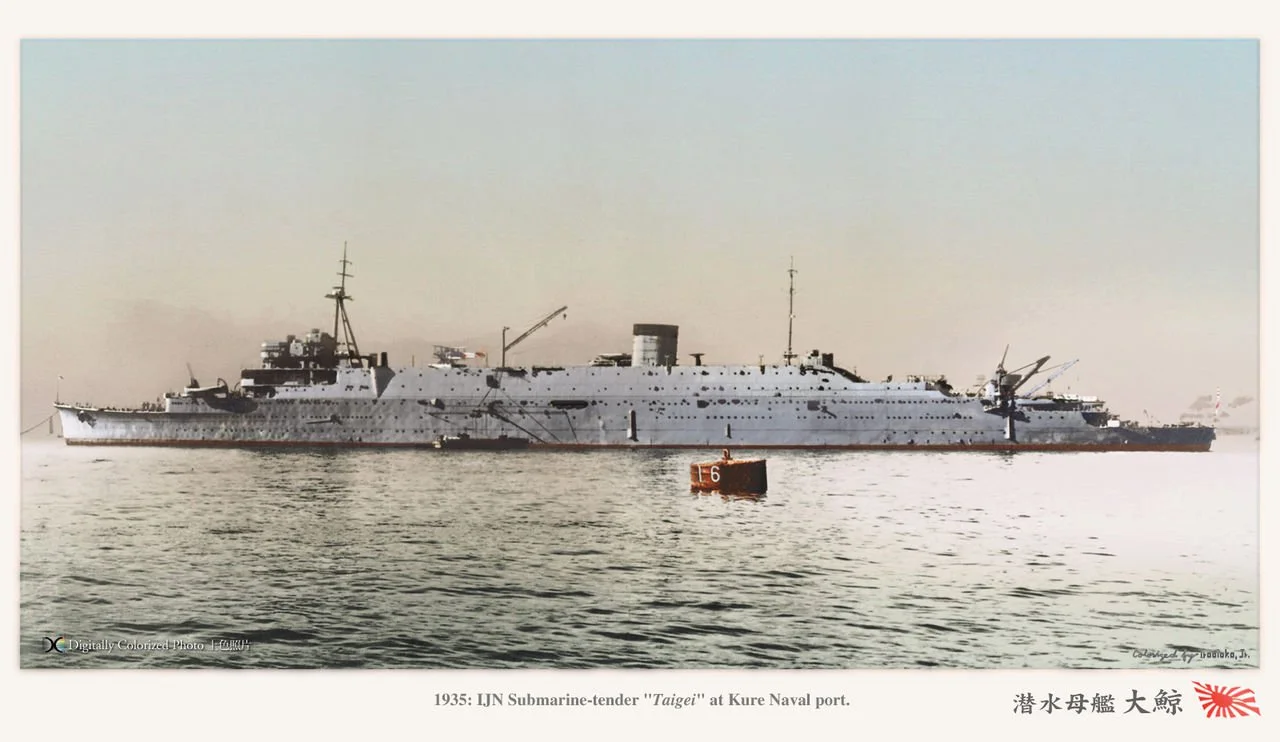
IJN Taigei, colorized by Irootoko Jr.
The London Naval Treaty imposed to Japan as other signatories severe cappings and tonnage limitations for capital ships that the Imperial Japanese Navy staff circumvented by building in part a fleet of auxiliary vessels, fleet oilers and submarine tenders with a design allowing them from the onset to be converted quickly into aircraft carriers in case of war. IJN Taigei was amonf these. She was ordered along the 1st Naval Armaments Supplement Programme of 1932.
Despite provisions were made for a quick conversion, her design proved problematic, suffered from a high freeboard and shallow draught, poor stability as a result. These defects were already prsent on IJN Ryujo ordered as a light carrier from the start, but fixed later. They were still there on IJN Ryūhō in 1941. Some problems appeared during construction as well. Extensive use of electric arc welding was used to speed construction, seen as very innovative at the time, but the Japanese lack experience in 1933 and this led to many weak welds, resulting later in many cracks as the ship started to operate.
Another identified issue was the inadequate sectioning of the below-waterline level, into waterproof compartments. This was less extensive for example that on IJN Ryujo. In the end, the “would-be carrier”, still completed as a submarine tender, showed poor performance due to the choice (which made sense for a tender) of diesel engines. Report of sea trials were clear about the fact they gave only half the output initally expected.
IJN Taigei: Design
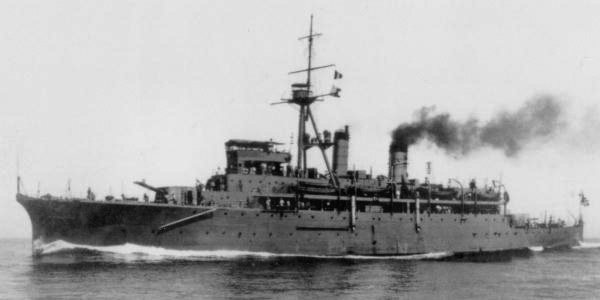
The previous IJN Jingei (1923), too small for new submarines.
As IJN Taigei (大鯨, “Big Whale”) was originally ordered and laid down on 12 April 1933 at Yokosuka Navy Yard. She was designed as a 10,500-ton submarine tender. Its origins laid with the introduction of new classes of large cruiser submarines: The existing Jingei-class submarine tenders were soon short in capacity to assist them. To meet new demands, a new generation of large submarine tender was passed under the 1st Naval Armaments Supplement Program of 1933.
IJN Taigei used new methods of construction to gain weigh and reach the greatest speed possible. To reduce weight, indeed electric welding was used for the first time in ship construction in Japan. This technique was to result in a 15% weight reduction, using intensively electric welding throughout. She was the first IJN’s all-welded warship.
This complex production was compounded later by the choice of powerful, also new diesel engines, another innovation to increase her autonomy at sea, as befitting the new cruiser submarines she was to care for. She was a large vessel, with a hull cruiser, 197 m long at the waterline (211 m overall), and 18 m wide, so a 1/10 ratio favourable to speed. Over her classic cruiser hull, reminiscent of the Myoko class, a large hangar superstructure, four decks high and stepped was built. She had a double bridge forward, one large and intended to be later “buried” after conversion under the flight deck, and a proper cruiser superstructure mounted on its roof, with a tripod containing a small telemeters and fire control station. A fire control tower was installed on the upper bridge’s roof.
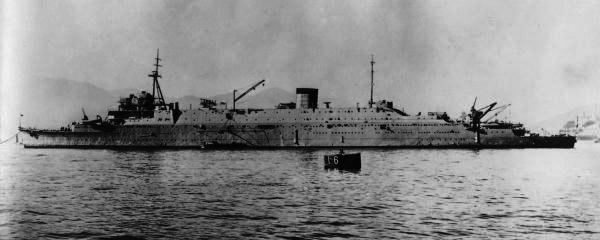
The main hangar roof was clean and flat, interrupted by a single Kure No. 2 5 type catapult on the port side, a lift in the centerline and railings to park 2-3 seaplanes in front of the single amidship funnel. There was also a crane, also on the port side, for recovery. These seaplanes were the Kawanishi (Type 95) E8N2, as she operated an entire squadron in China. Armament comprised two twin 12.7 cm (5 in) standard Type 89 fore and aft, and two twin 25 mm Type 96 in pairs fore and aft of the hangar roof deck after modernization, but at launch, twelve 13.2 mm AA machine guns, in twin and possibly single mounts.
Apparently IJN Taigei was built without heavy armor protection, but there was a bulge running along the waterline amidships and limited underwater protection. The large hangar house all amenities for submarine service, with a gradation by weight for stability: Food stuff and light parts and supplies were probably stored in the higher two-storey hangar, with torpedoes and ammunitions one deck below, and fuel tanks underwater. Taigei also had a single pole mast aft close to the aft superstructure supporting the aft guns telemeter and FCS.
She had two main light projector aft, in echelon fore and aft of the main funnel, and smaller ones in the bridge’s wings. There were three large protruding access hatches to the hanghar on either side, with smaller cranes. There were also two main derrick cranes either side of the aft deck to handle service boats.
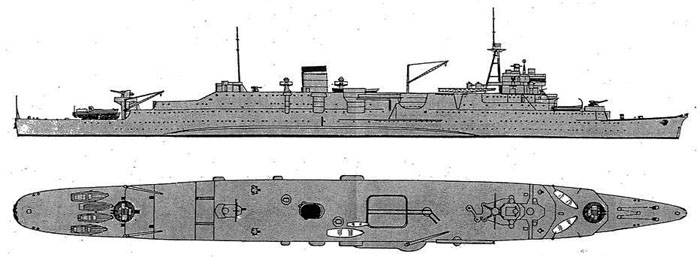
2 views
⚙ IJN Taigei Specs Dec. 1935 |
|
| Dimensions | 211 x 17 x 5.5 m (692.8″ x 59’3″ x 17’ 6″ feets/in) |
| Displacement | 10,500 t. standard ? t. Full Load |
| Propulsion | 2 shaft diesel, 14,000 bhp. |
| Speed | 14 knots ( km/h; mph) |
| Range | Unknown |
| Armament | 2×2 127mm AA, 12×3 13.2 mm AA |
| Crew | Circa 500 |
IJN Taigei’s service (1935-41)
IJN Taigei was from 20 October 1933 received its fist commanding officer, even before launch, Captain Tamazo Sukigara as Chief Equipping Officer. She was launched, baptised TAIGEI (“Large Whale”) an completed at Yokosuka on 31 March 1934, registered in the IJN still with Captain Sukigara, but now as Commanding Officer. However as soon as she started her sea trials problems appeared. Repairs and improvement continued. After completion she was also damaged by a typhoon, which had her repaired (see later).
On 15 November 1934 she was assigned to the Kure Naval Defense Force and Submarine School based in Otake, as a Training Ship, later under command of Captain Takasu Sanjiro appointed. On 26 September 1935, the “Fourth Fleet Incident saw mayhem as the combined fleet was caught in a severe storm while moving in northwest Pacific waters. The Typhoon battered the fleet for 13:00 hours with sustained 79 knots winds, plus 45-60 feet waves. Ships sank, other were badly damaged and IJN Taigei as well. Serious cracks in her all-electrically welded hull developed.
On 16 November 1936 she was still under repairs when a new CO was appointed, Moizumi Shinichi, following in December by Captain Minowa Chyugo. After the July 1937 Marco Polo Bridge Incident the IJA and IJN agreed on operational jurisdictions and the IJN strength in Shanghai was augmented to 30 warships. On 19 August 1937, Taigei, strznghtened, was at sea, assigned to the 23rd Air Division as a Seaplane Tender, carrying Sasebo’s 23rd Sea Scout squadron.
On 15 September 1937, she arrived in South China, based at Niujianshan. The 23rd Sea Scout Units were mostly transferred to the seaplane tender IJN Kagu maru and by October the remaining half of her seaplane unit (Type 95 “Dave”) was transferred to IJN NOTORO while the unit was disbanded. On 15 November Captain Mori Tokuji took command and on 25 May 1938 Nakazato Ryuji while in August, Taigei is assigned to SubRon.1, First Fleet.
On 15 December 1938 Harada Kaku became her new captain and in November 1939 Nakamura Motoji while she is versed to SubRon3, Second Fleet, and then SubRon3, Sixth Fleet. On 10 April 1941 Captain Okura Tomesaburo taks command, replaced by Kiyama Tatsuo on 10 November 1941. On 20 December, as the war broke out, she is redesignated “No. 3 Reserve Ship” in Kure Naval District, taken for conversion under supervision of Captain Kiyama.
Conversion into an aircraft carrier (1941-42)
Conversion of Taigei ainto an aircraft carrier started in December 1941, a process that took more than expected as she was completed after a full year. The conversion was performed at the Yokosuka Naval Arsenal, but delayed due to damage caused by the Doolittle Raid, in April 1942. It was completed in November 28.
It comprised first the installation of a 185 x 23 m (607 by 75 feets) flight deck. The hangar was served by 13.6 x 12.0 m (44.6 by 39.4 feets) elevators. Diesel engines were removed before that, replaced by Kampon steam turbines identical to the Kagero-class destroyers. However due to the increased displacement, side bulges, speed fell by two knots.
IJN Ryuho became one of the least successful light aircraft carrier conversions. Small, with a too slow speed for effective fleet service, weak construction, small hangar space and air group, poor instability and weak protection, especially underwater. Therefore, she was quickly sidelined as a “fleet carriers” and became more of an auxiliary aicraft carrier.
Hull & protection
The basic hull was kept, but with the addition of structural strenght, bulges, and the addition of flight deck, her dimensions changed. She was 215,65 m long, 19.58 m wide, with 6,67 m draft (707 feets, 64 feets and 21 feets) with a displacement now of 19,000 tonnes Fully Loaded. Due to her weak propusion, even when swapping on new turbines, she stayed slow at 26.5 knots, precluding fleet operations. Protection was not much improved, and she could have been sunk with a single torpedo hit, a scenario that likely would have happened several times during her service life.
Armament
She had four twin standard 127mm/40 (5 in) Type 89 AA main dual pusrpose guns in sponsons, two on either side, and ten triple 25 mm AA type 96, four twin of the same for 38 barrels total and six depht charges at the stern, in racks. This likely did not changed during her short career. She also could carry 36 aircraft (see below).
On board aviation
Flight wing comprised 31 aircraft: About 1/3 Mitsubishi A6M “Zero” fighters, 1/3 Aichi D3A “Val” and 1/3 Yokosuka D4Y “Judy”, both being dive bombers, plus Nakajima B5N “Kate” TBs in alternative, but rarely all four types together. Combat operations had this air group siecialized, to escort missions rather than strikes over time. By August 1944 since her flight deck grew to 198.1 meters after an overhaul, her air group was 36, but since skilled pilots were a rarity, its effectiveness stayed about the same.
In june 1943 she carried 21 A6M2 “Zero” and 9 B5N “Kate” (so 30) and exactly one year later at the battle of the Philippines, she carried 9 A6M2 “Zero” fighters (likely kept for the CAP), 18 A6M5 fighters, and 9 B6N Tenzan “Jill”. She lost her last active air group, decimated in the Marianas “Turkey Shoot”. Later she was only used to taxi planes to Formosa.

Author’s illustration of Ryuho as completed.
⚙ IJN Ryūhō Specs Dec. 1942 |
|
| Dimensions | 215,65 m long, 19.58 m wide, 6,67 m draft (707 x 64 x 21) |
| Displacement | 16,700 t. standard -19,000 t. Full Load |
| Propulsion | 4 shafts geared turbines, 4 boilers, 52,000 shp. |
| Speed | 26.5 knots (50 km/h; 30.5 mph) |
| Range | 8,000 nmi (15,000 km; 9,200 mi) at 18 knots (33 kph, 21 mph) |
| Armor | None |
| Armament | 4×2 127mm AA, 10×3 25 mm AA, 6 DCs, 36 aircraft |
| Crew | 989 |
Sources/ Read more
Books
Conway’s all the worlds fighting ships 1922-1947
Brown, David (1977). Aircraft Carriers. New York: Arco Publishing.
Brown, J. D. (2009). Carrier Operations in World War II. Annapolis
Campbell, John (1985). Naval Weapons of World War Two. Annapolis
Chesneau, Roger (1995). Aircraft Carriers of the World, 1914 to the Present: An Illustrated Encyclopedia (New, Revised ed.). Annapolis
Dull, Paul S. (1978). A Battle History of the Imperial Japanese Navy, 1941–1945. Annapolis
Jentschura, Hansgeorg; Jung, Dieter & Mickel, Peter (1977). Warships of the Imperial Japanese Navy, 1869–1945. Annapolis
Peattie, Mark (2001). Sunburst: The Rise of Japanese Naval Air Power 1909–1941. Annapolis
Polmar, Norman & Genda, Minoru (2006). Aircraft Carriers: A History of Carrier Aviation and Its Influence on World Events. Potomac Books.
Stille, Mark (2005). Imperial Japanese Aircraft Carriers 1921-1945. Osprey Publishing.
Watts, Anthony J. (1971). The Imperial Japanese Navy. New York: Doubleday.
Links
Some 1945 Footage: Ryuho, Yoizuki & Natsuzuki in Kure Harbor
The model’s corner

Fujimi 1/700 (scalemates)
IJN Ryūhō’s career
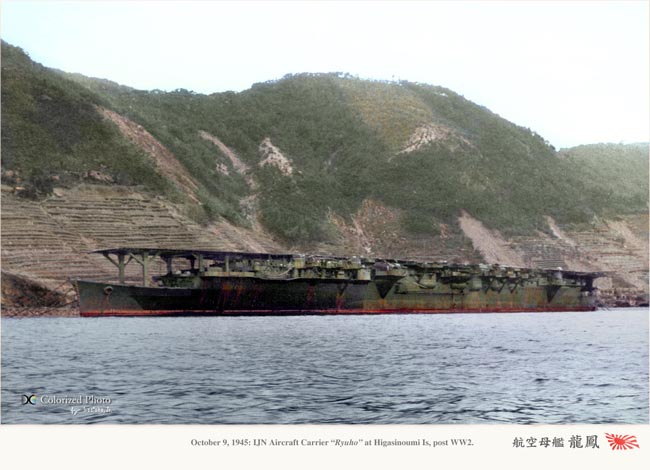
ryuho in Kure, 1945, colorized by irootoko jr
By December 1942 with the Kido Butai gutted and in the Solomons, the order of the day was defensive. The poor performances showed IJN Ryuho had her relegated as as an aircraft transport or used for training in home waters, replacing the now very old IJN Hosho, when the latter was in maintenance. She operated with the Second Carrier Division, 3rd Fleet, in 1943, ferrying aircraft to Singapore as well as the Philippines, Tarakan, Palau, Truk, Saipan. She also trained pilots near the Marianas Islands.
In 1944 she was still pressed into active service, taking part in the first Battle of the Philippine Sea (June 1944), and on 31 December 1944, ferried aircraft to Taiwan, her last mission, and being the last japanese carrier outsisde home waters after the battle of Leyte. Air attacks in Kure in July 1945 had her badly damaged and she was captured in that state in September, BU later.
Completion and commission
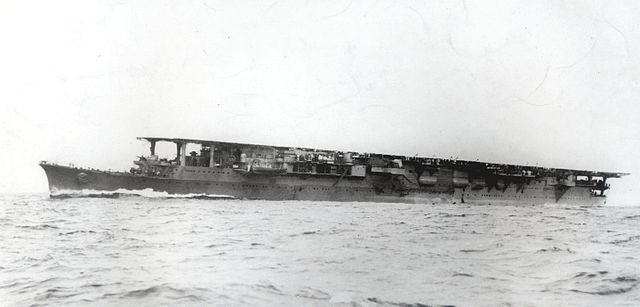
Sea trials, November 1942
On 18 April 1942 while in dock at Yokosuka she suffers damage from B-25 bombs during the Doolittle Tokyo raid. The bomber was piloted by Lt. Edgar E. McElroy’s Crew (serial S/N 40-2247). The single direct bomb hit on the bow added to 30 incendiary bomb hits caused nevertheless a light damage as well as seven casualties. This delayed her completion as damaged or burned parts were retired and replaced anew, under supervision of newly appointed Captain Soma Shinshiro. On 20 October 1942 she is assigned to Maizuru Naval District (Reserve Ship #1). on 1st Captain Kamei Yoshio taked command. On 30 November 1942 at last, IJN Taigei had her conversion completed. She was recommissioned as IJN RYUHO under command of Captain Kamei. She was officially assigned to the 3rd Fleet.
Early missions (Jan 1943-May 1944)
Her first sortie started on 11 December 1942 at the Japanese naval base at Truk, escorted by IJN Tokitsukaze. Normal aircraft complement at that time comprised 15 Mitsubishi A6M “Zero”, 16 Aichi D3A “Val”, plus a reserve on deck of 20 light bombers. At 09:10 on 12 December, she is ambushed underway by USS Drum near Hachijojima. Hit by a single torpedo on the starboard side, she immediately returned to Yokosuka for emergency repairs. This had her and out of business until early 1943.
On 19 March 1943, IJN Ryūhō was at sea again. First she moved from Yokosuka for Oita, Inland Sea. She started a serie of aircraft ferry missions to various occupied islands in the South Pacific. They remained secret in April-May, precise records are lost. On 11 June 1943, IJN Ryūhō picked up marooned survivors of the fellow carrier IJN Hiyō’s air group, badly damaged by an American submarine, on Hashira-jima, bound for Yokosuka. She was assigned to the Second Carrier Division (CarDiv 2), 3rd Fleet, on 12 June, removed from 3rd Force, Mobile Force Training Force.
She departs Yokosuka with the escort carriers IJN Unyō and Chūyō, escorting them to Truk and back (arrived 21 June 1943, departed 19 July 1943 while being in between reassigned to the main mobile force). Later she was seen in the Seto Inland Sea for training missions in replacement of IJN Hosho in drydock. She was indeed reassigned to Maintenance Force, Mobile Force, remaining in the western Inland Sea. In July and August she trained in the southern part of the home islands, stopping at Kinetsuri, Beppu, and Hashirajima.
On 2 September 1943 she was relieved of HIYO’s air group that she trained extensively and was reassigned to Mobile Force, Stand-by-Force, returned to Kure. On 22 September 1943 she entered the drydock at Kure for a refit, than on 27 September 1943 leaves the drydock and on 6 October 1943, departed Kur for the Inland Sea ports arriving on 10 October 1943 at Saeki. On 11 October she departed Saeki for Singapore, via Sama, stopping there on 15-16 October 1943.
On 19 October 1943, IJN Ryūhō arrived to Seletar, Singapore, ferrying more planes, and was back to Kure on 5 November via Sama. On 25 November 1843, she departed with IJN Hiyō and their escorting destroyers for a long circular patrol, starting with the Taira Islands the Manila (29 November), training along the way, Singapore (3 December), Tarakan (14 December), Palau (18 Dec.), Truk (22 Dec.), Saipan (29 Dec.), and back in Kure on 2 January 1944. She was drydocked for maintenance on 17-28 January and staye din hom waters for training. On 16 March 1944 Captain Matsuura Yoshi takes command.
She made afterwards two more uneventful patrol and training missions between Japan and the Marianas Islands: On 1 April 1944 she Arrives at Saipan, and was back in Kure on 8 April 1944, then departed on the 24th for a cruise around Taira Islands and off of Iwakuni, being back in Kure on 27 April 1944.
1st Battle of the Philippine Sea (20 June 1944)
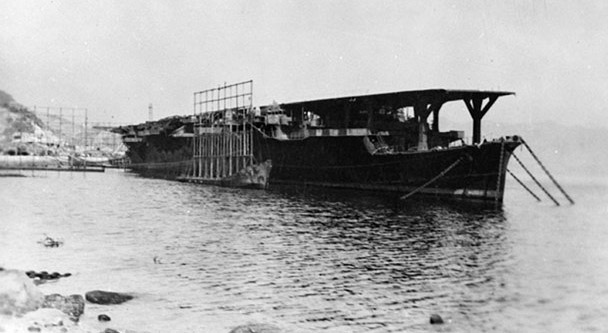
Ryūhō was sent to the Japanese anchorage at Tawi Tawi in May 1944, departing on the 11th to join the Combined Fleet, mobile fleet. From there, she sailed on 13 june with the Combined Fleet to participate in the First Battle of the Philippine Sea. It was Operation “A-Go”, activated on 20 May 1944. On 14 June 1944 she arrive at Guimaras, and departs the next day to take her launching position for the Marianas. On 19 June, she launched an air strike against Task Force 58.
Her air group founds its targets but unfortunately scored no hits while takinh a heavy punishement: Nearly all of her aircraft are shot down by F6F Hellcat fighters, the remainder by the task force’s anti-aircraft barrage. On 20 June she was in “Force B”, also comrising the carriers IJN Hiyō, Junyō, covered by the battleship Nagato, cruiser Mogami and eight destroyers. IJN on the following day at 17:30 reports came of an incoming USN air attack.
At 18:10 RYUHO bomb-loaded TBFs from USS Enteprise and she suffers moderate concussion and shrapnel damage from near-misses. This was not enough to have her navigation of fighting capability impaired. indeed, unlike carriers with offset standard deck islands, like most IJN conversions, her bridge was located below the flight deck, out of harm. In fact, the damage inflicted was so was light as not even remarked or noted in Ugaki’s diary, whioch however related what happened to IJN CHIYODA.
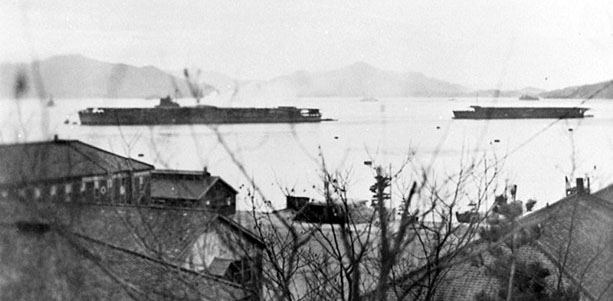
IJN Ryūhō’s summer was relatively quiet. On 22 June 1944 she arrived at Okinawa, departed the next day and was back with the Mobile Fleet to Hashirajima. On 3 July 1944 she was back in Kure, on 10 July removed from CarDiv 2, moved to CarDiv 1, 3rd Fleet and entered drydock the following day for repairs to mostly her flight deck. Decision was made however to lengthen the flight deck at its forward, extended fully to the bow. This enabled her to launch heavy aircraft as they were introduced.
On 20 July she Left the drydock and after post-fixe trials and training on 10 August 1944 she was rassigned to CarDiv 4, 3rd Fleet an departed two days later for Hashirajima and on the 22th, for Yashima. She trained there and headed back to Hashirajima on 26 August, reassigned to CarDiv 4, 3rd Fleet. Next, she engaged in several more patrol and training missions near Japan: On 10 September she moved from Hashirajima to Yashima and Kure. Until the 25 of October she never left home waters, only making short trips to Kure, Iwakuni, Yashima, Iwakuni, Tokuyama, Iwakuni, Kure, Iwakuni, Yashima, Oita, Kure, Moji, Yuya-wan, and Sasebo staying one of 2-3 days each time.
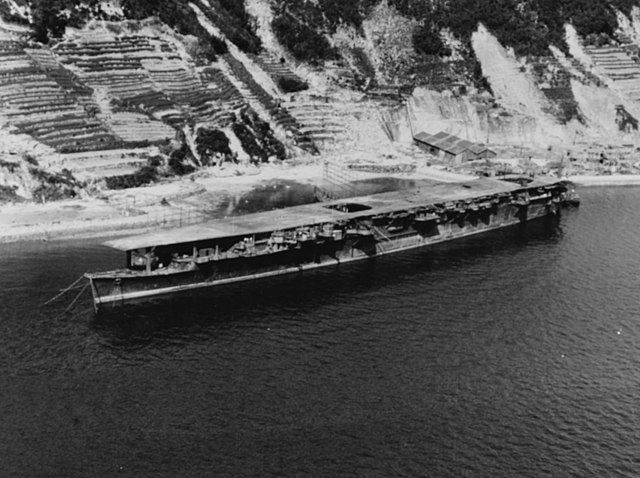
Ryuho photographed by a plane from USS Siboney in October 1945.
On 25 October, she departed Sasebo with the escort carrier IJN Kaiyō, Ryūhō carrying an aircraft ferry mission to Keelung in Formosa (Taiwan). The convoy was escorted by the old destroyers Momi, Ume and Momo. They arrived at Keelung on 27 October 1944 and disembarked their planes, then headed for home on the 30th. The fleet was back home on 2 November 1944 at Kure. On 7 November, she departed Otake and arrived at Kure, and from 7 to 15 November, Ryūhō had the honor of serving as flagship, Commander of the Mobile Fleet, Admiral Jisaburō Ozawa.
The remainder of November, she moved to Uji (12th), the Mobile Fleet is abolished on 15 November 1944, and she is reassigned to CarDiv 1, Combined Fleet. On the 21th she depart Kure and arrive at Matsuyama, remaining there for the rest of the month. On 13 December, she was ordered with UNRYU to make preparations for carrying a load of Yokosuka MXY-7 Ohka suicide missiles to Manila and Formosa (Taiwan) as the Allied invasion was just reported, bound for Mindoro. The mission is postponed however just as a report came confirming Mindoro and also the loss of IJN UNRYU.
Final mission
On 31 December 1944, Ryūhō and convoy HI-87 sailed from Moji as part of “special transport force” for Formosa (Taiwan) with its 58 Ohka “baka” kamikaze planes onboard with nine empty oil tankers to be refilled in Singapore, and an escort constituted by the destroyers IJN Hamakaze, Isokaze, Yukikaze, Shigure and Hatakaze. Yukikaze however later suffers a burst steam pipe and was obliged to fold back to the Inland Sea.
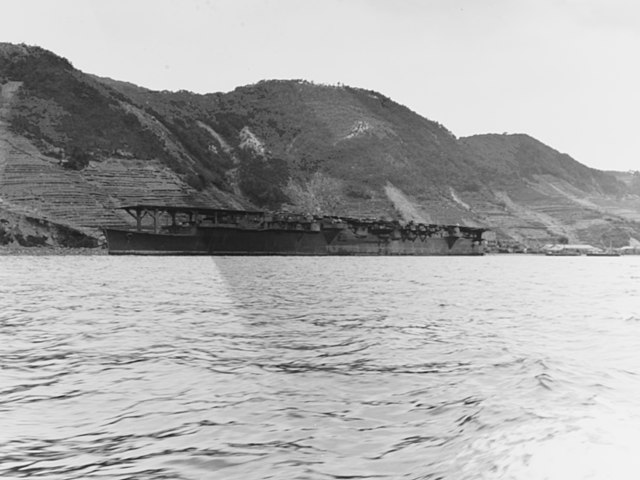
On the 7th, off Keelung, she undergo a submarine attack. Torpedoes reached one of the tankers, damaged but not sunk. The carrier is safe, and proceeds with shigure into Keelung. Unloading her cargo on the 8-9, peace was soon broken: Indeed, IJN Ryūhō was among the targets present when USN carrier-based air raids started. 12 TBF Avengers attacked the carrier, none scored a hit, and in return her gunners claimed to have shot down one of them (confirmed later). IJN Ryūhō the departed on 2 January 1945, escorted by IJN Isokaze. She was back in Kure on 18 January, gaining the distinction of being the very last IJN carrier to venture outside home waters.

Anchored in Kure Bay, Yoshiura Point.
However Task Force 58 air groups had her on their list. On 20 January 1945 Captain Takahashi Chojuro takes command as CO. Nothing much happened in the remainder of the month and February. She is anchored off Kure. On 19 March
at 07:20 and until 09:05, off Yoshiura Point (Kure bay) she is spotted and attacked by TF 58, severely damaged by three direct 500 lb bombs hits, plus two 5.5-inch rocket hits. The flight deck is devastated between the two lifts. The No.1 boiler room is punctured by a bomb fragment, and there was another large gash in the port quarter, causing a massive flooding. She eventually settles 6 feet aft while teams tries to combat a fierce fire. 20 of the crew are killed, 30 wounded during the attack and its aftermath.
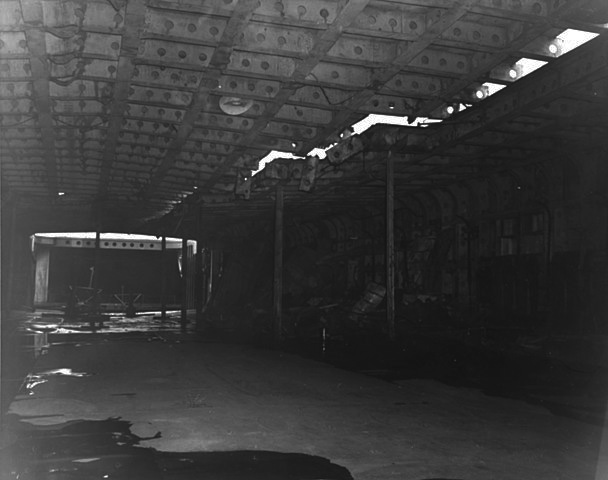
Hangar deck examined on 9 October 1945
On 23 March 1945, HOSHO is assigned as radio guard for RYUHO while teams tries to frantically repair her. On 31 March a new attack in Kure again takes her as a target. When she return to Kure on 1 April, she is considered to be a total loss after being examined in the drydock, pumping out the flooded stern. Repairs are cancelled. On the 20th, she is effectively removed from CarDiv 1, 2nd Fleet, assigned to #4 Reserve Ship in the Kure Naval District. Captain Takahashi left without replacement, despite a possible USSBS survey of October 1945 stating her CO was “Captain Hojima”, most probably a confusion with the caretaker officer. On 24-28 July she is moored close to Eta-jima, off Kure and close to IJN Haruna, the last survivor of the old a
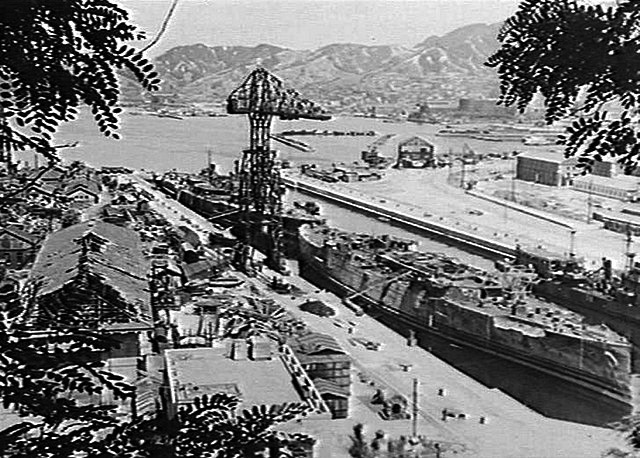
Ryuho scrapped on 15 October.


 Latest Facebook Entry -
Latest Facebook Entry -  X(Tweeter) Naval Encyclopedia's deck archive
X(Tweeter) Naval Encyclopedia's deck archive Instagram (@navalencyc)
Instagram (@navalencyc)





 French Navy
French Navy Royal Navy
Royal Navy Russian Navy
Russian Navy Armada Espanola
Armada Espanola Austrian Navy
Austrian Navy K.u.K. Kriegsmarine
K.u.K. Kriegsmarine Dansk Marine
Dansk Marine Nautiko Hellenon
Nautiko Hellenon Koninklije Marine 1870
Koninklije Marine 1870 Marinha do Brasil
Marinha do Brasil Osmanlı Donanması
Osmanlı Donanması Marina Do Peru
Marina Do Peru Marinha do Portugal
Marinha do Portugal Regia Marina 1870
Regia Marina 1870 Nihhon Kaigun 1870
Nihhon Kaigun 1870 Preußische Marine 1870
Preußische Marine 1870 Russkiy Flot 1870
Russkiy Flot 1870 Svenska marinen
Svenska marinen Søværnet
Søværnet Union Navy
Union Navy Confederate Navy
Confederate Navy Armada de Argentina
Armada de Argentina Imperial Chinese Navy
Imperial Chinese Navy Marinha do Portugal
Marinha do Portugal Mexico
Mexico Kaiserliche Marine
Kaiserliche Marine 1898 US Navy
1898 US Navy Sovietskiy Flot
Sovietskiy Flot Royal Canadian Navy
Royal Canadian Navy Royal Australian Navy
Royal Australian Navy RNZN Fleet
RNZN Fleet Chinese Navy 1937
Chinese Navy 1937 Kriegsmarine
Kriegsmarine Chilean Navy
Chilean Navy Danish Navy
Danish Navy Finnish Navy
Finnish Navy Hellenic Navy
Hellenic Navy Polish Navy
Polish Navy Romanian Navy
Romanian Navy Turkish Navy
Turkish Navy Royal Yugoslav Navy
Royal Yugoslav Navy Royal Thai Navy
Royal Thai Navy Minor Navies
Minor Navies Albania
Albania Austria
Austria Belgium
Belgium Columbia
Columbia Costa Rica
Costa Rica Cuba
Cuba Czechoslovakia
Czechoslovakia Dominican Republic
Dominican Republic Haiti
Haiti Hungary
Hungary Honduras
Honduras Estonia
Estonia Iceland
Iceland Eire
Eire Equador
Equador Iran
Iran Iraq
Iraq Latvia
Latvia Liberia
Liberia Lithuania
Lithuania Mandchukuo
Mandchukuo Morocco
Morocco Nicaragua
Nicaragua Persia
Persia San Salvador
San Salvador Sarawak
Sarawak Uruguay
Uruguay Venezuela
Venezuela Zanzibar
Zanzibar Warsaw Pact Navies
Warsaw Pact Navies Bulgaria
Bulgaria Hungary
Hungary

 Bundesmarine
Bundesmarine Dutch Navy
Dutch Navy Hellenic Navy
Hellenic Navy Marina Militare
Marina Militare Yugoslav Navy
Yugoslav Navy Chinese Navy
Chinese Navy Indian Navy
Indian Navy Indonesian Navy
Indonesian Navy JMSDF
JMSDF North Korean Navy
North Korean Navy Pakistani Navy
Pakistani Navy Philippines Navy
Philippines Navy ROKN
ROKN Rep. of Singapore Navy
Rep. of Singapore Navy Taiwanese Navy
Taiwanese Navy IDF Navy
IDF Navy Saudi Navy
Saudi Navy Royal New Zealand Navy
Royal New Zealand Navy Egyptian Navy
Egyptian Navy South African Navy
South African Navy






























 Ukrainian Navy
Ukrainian Navy dbodesign
dbodesign